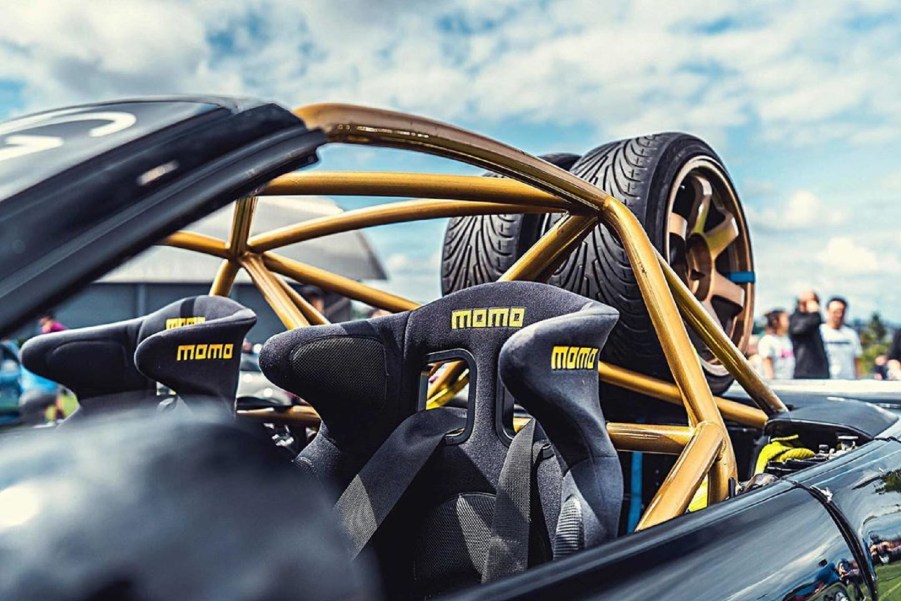
Should You Install Racing Seats in a Street Car?
While giving your car a turbo is just about adding power, some modifications pull double-duty. For example, while roll cages provide crash and roll protection, they also make cars stiffer, which makes for better handling. Another mod like this? Aftermarket racing seats. Quite a few high-performance road cars, like the EP3 Honda Civic Type R, have offered heavily-bolstered racing seats over the years. But does that mean you should install them in your road car?
A racing bucket seat vs. a conventional seat
Your car’s factory seats are designed around several factors. One is comfort, not just based on the padding, but on how the seat maintains a good posture. Another is efficiency—fitting the maximum number of people into the space allowed. That’s why many larger vehicles, like trucks, minivans, and SUVs, offer flat bench seats in the rear, Cars.com reports.
Additionally, many modern seats have built-in luxury and safety features, FCP Euro reports. These include heating elements, ventilation, sensors, and airbags. Essentially, the goal of a seat is to keep you in it.
However, while your average single-person bucket seat may be fine in typical traffic situations, it has its limits. Especially once the road gets curvy and you decide to pick up some speed, Drifted reports. Take one corner too quickly, and you can end up sliding into your passenger, or into the door. Once that happens, you risk losing control of the car and causing further problems.

That’s where racing seats come in, The Drive reports. Superficially, a racing seat resembles a conventional seat in shape. But racing seats have heavier bolstering, and often come with integrated headrests. And the most expensive and hard-core models have fixed backs, Autoweek reports.
Besides adding some styling flair, the racing seats’ design helps keep you in place. The side bolsters prevent you from sliding off in high-speed corners, and the integrated headrest stops your head from moving around. That’s especially important given the risk of whiplash and concussion. Basically, a racing seat is kind of like a giant child car seat. Some racing seat suppliers, such as Recaro, make child seats as well.
But there’s another benefit provided by racing seats: safety. Sort of.
Installing a racing seat: what goes into it, and the pros and cons
While conventional seats are mostly one-size-fits-all, racing seats need to be sized to the driver, CarBibles reports. They also need to be positioned properly within the car itself. Not just to let the driver reach the controls and pedals, but also to allow for racing harness installation.
That’s the biggest benefit of racing seats, SpeedHunters explains. Because of the forces and speeds involved in racing, a simple 3-point seat belt isn’t enough. Instead, racers use multi-point safety harnesses, which distribute impact forces across a wider area. Combined with a racing seat, a 5- or 6-point harness will keep solidly in place during your driving session.
If you’re fitting a racing harness, you’ll need to install a racing seat, SpeedHunters reports. Without the integrated headrests and proper openings for the belts, the harness simply won’t work properly.
But the racing seat itself isn’t enough. If you’re going all the way into racing, you’ll need to install a harness bar or a proper roll cage to secure the harnesses. And that heavily impacts useful interior space, Autoweek reports. If you have a harness bar, even one that bolts into OEM attachment points, you’re not carrying rear passengers.
But even if you’re planning on sticking to the streets, or some mild autocross, a racing seat without harnesses carries some drawbacks. Firstly, it’s harder to get in and out of a heavily-bolstered seat than a conventional one. Secondly, if you install a fixed-back seat, it won’t be as comfortable as the original one. And finally, while FIA-rated racing seats may be made of strong materials like carbon fiber, they lack airbags and electronics. It makes them light, but it also eliminates some of those safety and luxury features.
Costs and alternatives
With older cars, installing an aftermarket racing seat is fairly straightforward. Measure yourself, the interior, and determine if you want the seat to slide or not. Then it’s just a matter of bolting in the hardware.
With modern cars’ sensors and various electronics, however, the installation is more complicated. You might need to tinker with the wiring, FCP Euro reports, or reprogram the ECU. Some suppliers, though, have products that interface directly with the electrical system.
The cost of a racing seat varies based on the model and intended purpose. A reclining one for my NB Miata can cost as little as $300 or as much as $3000. The fixed bucket ones meant for proper racing are often even more expensive. And these prices don’t include installation or the cost of any racing harnesses or harness bars.
But, if you just want your current seats to hold you more securely, there is a cheaper alternative: aftermarket bolsters. Flyin’ Miata sells some from Paco Motorsports that cost $129. If you’re not planning on actually racing, this might be the better option.
Follow more updates from MotorBiscuit on our Facebook page.


